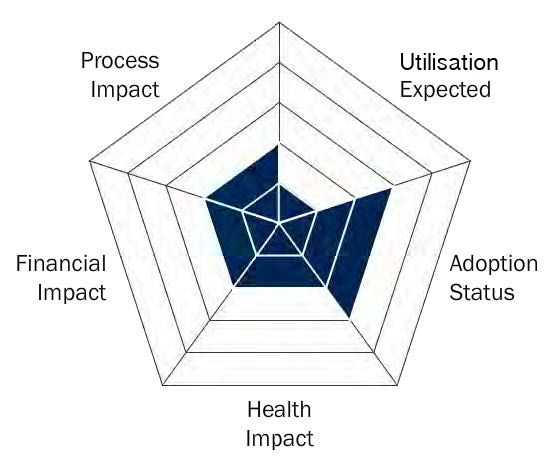HealthManagement, Volume 15 - Issue 4, 2015
- In June 2011, the U.S. National Cancer Institute’s (NCI’s) National Lung Screening Trial (n = 53,454 current or former heavy smokers aged 55 to 74) reported these findings regarding screening with lowdose helical computed tomography (LDCT) compared with chest x-ray: individuals screened with LDCT had a 15% to 20% lower risk of dying from lung cancer than individuals screened using standard chest x-ray (National Lung Screening Trial Research Team 2011). This means that about 3 fewer deaths per 1,000 people screened occurred in the LDCT group than in the chest x-ray group over a period of about 7 years of observation (17.6 per 1,000 vs. 20.7 per 1,000, respectively).
- Study authors also reported that after 3 rounds of screening, on average, 24.2% of LDCT screens and 6.9% of chest x-rays were positive. These positive results usually led to additional testing.
- The authors also reported that certain types of lung cancer were detected more often at the earliest stage by LDCT (adenocarcinomas and squamous cell carcinomas) than by chest x-ray. However, small-cell lung cancers, which are very aggressive, were not often detected at early stages by either method.
- To improve LDCT screening accuracy, some developers have proposed using a class of pattern-recognition software called computeraided detection (CADe) to analyse radiologic images. The software is intended to identify patterns suggestive of disease and highlight them for radiologist review. Use of the technology requires additional staff time for interpretation and modestly increased data processing and storage capacity.
- Adding CADe capability to a computed tomography (CT) system could cost up to $65,000 (€57,250) per license (ie, for each radiologist user), but additional reimbursement for its use is not available, even though CADe has been available since 2006. Two studies report that CADe adds up to 80 seconds for LDCT image review (Matsumoto et al. 2013; Bogoni et al. 2012); additional data storage requirements for CADe use are considered to be small to negligible.
- Although several clinical guidelines recommend LDCT screening in the population defined in the NCI trial, they are silent on the role of CADe to improve LDCT screening accuracy (Detterbeck et al. 2013; Jaklitsch et al. 2012; Wender et al. 2013; American Lung Association Lung Cancer Screening Committee 2015; National Comprehensive Cancer Network (NCCN) 2015a; 2015b; Moyer VA; U.S. Preventive Services Task Force 2014)
- A primary safety concern about using CADe for LDCT screening is the risk of increasing the rate of false-positive results. False positives often lead to additional testing and potential harm from unnecessary treatment from overdiagnosis of lung lesions unlikely to cause clinical symptoms.
- Clinical trials are needed to determine whether CADe has an appropriate role for improving accuracy of LDCT for lung cancer screening. We identified one relevant ongoing study in China (Shanghai Changzheng Hospital), that may provide data in 2017 to further elucidate the role of CADe in LDCT screening.

About ECRI
ECRI Institute, a nonprofit organisation, dedicates itself to bringing the discipline of applied scientific research in healthcare to uncover he best approaches to improving patient care. As pioneers in this science for nearly 45 years, ECRI Institute marries experience and independence with the objectivity of evidence-based research.
ECRI ’s focus is medical device technology, healthcare risk and quality management, and health technology assessment. It provides information services and technical assistance to more than 5,000 hospitals, healthcare organisations, ministries of health, government and planning agencies, voluntary sector organisations and accrediting agencies worldwide. Its databases (over 30), publications, information services and technical assistance services set the standard for the healthcare community.
More than 5,000 healthcare organisations worldwide rely on ECRI Institute’s expertise in patient safety improvement, risk and quality management, healthcare processes, devices, procedures and drug technology. ECRI Institute is one of only a handful of organisations designated as both a Collaborating Centre of the World Health Organization and an evidence-based practice centre by the US Agency for healthcare research and quality in Europe. For more information, visit www.ecri.org.uk
References:
American Lung Association Lung Cancer Screening Committee (2015)* Providing guidance on lung cancer screening to patients and physicians. Chicago, IL: American Lung Association. [Accessed: 20 October 2015] Available from lung. org/assets/documents/lung-cancer/lung-cancerscreening-report.pdf
Bogoni L, Ko JP, Alpert J et al. (2012) Impact of a computer-aided detection (CAD) system integrated into a picture archiving and communication system (PACS) on reader sensitivity and efficiency for the detection of lung nodules in thoracic CT exams. J Digit Imaging, 25(6): 771-81.
Detterbeck FC, Mazzone PJ, Naidich DP et al. (2013) Screening for lung cancer: diagnosis and management of lung cancer, 3rd ed: American College of Chest Physicians evidence-based clinical practice guidelines. Chest, 143(5 Suppl): e78S-92S.
Jaklitsch MT, Jacobson FL, Austin JH et al. (2012) The American Association for Thoracic Surgery guidelines for lung cancer screening using lowdose computed tomography scans for lung cancer survivors and other high-risk groups. J Thorac Cardiovasc Surg, 144(1): 33-8.
Matsumoto S, Ohno Y, Aoki T et al. (2013O Computer-aided detection of lung nodules on multidetector CT in concurrent-reader and secondreader modes: a comparative study. Eur J Radiol, 82(8): 1332-7.
Moyer VA; U.S. Preventive Services Task Force (2014) Screening for lung cancer: U.S. Preventive Services Task Force recommendation statement. Ann Intern Med, 160(5): 330-8.
National Comprehensive Cancer Network (NCCN) (2015a)* NCCN guidelines for patients®: non-small cell lung cancer. Version 1.2015 [slide set]. Fort Washington, PA: National Comprehensive Cancer Network (NCCN).[Accessed: 20 October 2015] Available from nccn.org/patients/guidelines/nscl
National Comprehensive Cancer Network (NCCN) (2015b)* NCCN clinical practice guidelines in oncology: lung cancer screening. V1.2016. Fort Washington, PA: National Comprehensive Cancer Network (NCCN). Accessed: 20 October 2015] Available from nccn.org/professionals/physician_ gls/pdf/lung_screening.pdf
National Lung Screening Trial Research Team (2011) Reduced lung-cancer mortality with lowdose computed tomographic screening. N Engl J Med, 365(5): 395-409.
PricePaid [database online] (2014). Plymouth Meeting, PA: ECRI Institute. [accessed 2014 Aug 27]. Syngo Imaging. Available from ecri.org.
Shanghai Changzheng Hospital. Screening for Early Lung Cancer in Shanghai, China. In: ClinicalTrials.gov [Internet]. Bethesda (MD): National Library of Medicine (US). 2000- [cited 2015 October 19]. Available from clinicaltrials.gov/ show/NCT02185495
Wender R, Fontham ET, Barrera E Jr, et al. (2013) American Cancer Society lung cancer screening guidelines. CA Cancer J Clin, 63(2): 106-17.
* denotes citations updated by HealthManagement.org


